Mont
Fourchon snowshoe adventure
Staying with the monks
in Grand Saint Bernard monastery 
|
|
|

|
|
|
 |
 |
Article
author: Kingsley. He's guided this trip dozens of
times, and in this article he explains why it is
such a special experience, and why anyone keen on
snowshoeing should do this trip at least once in
their lives. In his opinion, the summit is one of
the finest peaks you can reach on snowshoes. |
|

|
 |
 |
Some
days in the mountains are special, and I don't want to
share them with anyone else, which keeps them even more
memorable. Other experiences are for sharing, and the
story is worth telling to encourage them to go out and
explore this region themselves. I blame my interest in
snowshoeing to Mont Fourchon on my dog Maximus. He's a
Bernese Mountain Dog, with a large appetite for long walks,
and an even larger appetite for stealing my sandwiches
when we stop for lunch on the mountain. I've had him since
a pup, and he goes everywhere with me in the mountains
when I'm guiding snowshoeing groups.

Over the past 7 years, together we've crossed the Alps
on many occasions, and Col du Mont-Joux at 2473m is the
lowest pass over the mountains all the way between Mont
Blanc and the Monte Rosa. Nestled on the pass is the Grand
Saint Bernard monastery built nearly one thousand years
ago in 1047, and it provides a great base for ascending
one of the many summits beyond. Mont Fourchon is always
my first choice of peaks in the region, as the slope angles
are perfect for snowshoeing, and the summit views over
the Grand Combin and other Swiss Valais peaks are stupendous. |
 |
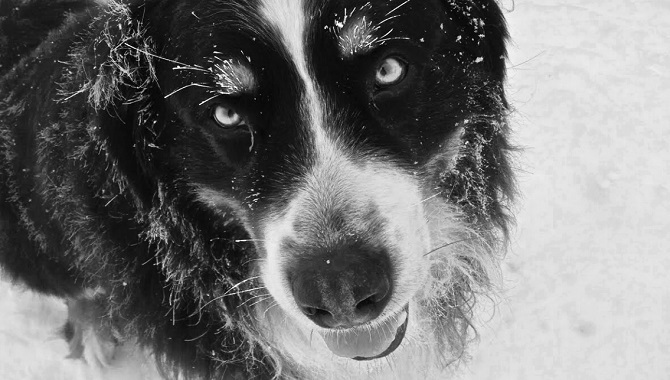 |
 |
The
Grand Saint Bernard always will be synominous with the
Saint Bernard mountain dogs, despite them being housed
in the valley by the Barry Foundation charity in the winter
months these days, no longer kept at the monastery to
help the monks rescue lost travellers in storms. My dog
is a Bernerse, the second largest of the Swiss mountain
dog breeds, and the Saint Bernard is the largest and heaviest.
It was wanting to take my dog to visit the home of the
largest breed that first attracted me to the region, and
I've never been disappointed since.

Despite the pass being called the Col du Mont-Joux on
old maps, recent maps always refer to it as the Col du
Grand Saint Bernard, and it straddles the border between
Switzerland and Italy. The name change was due to the
a certain Bernard of Menthon who was born around 1020
in the Annecy region of France. He renounced the advantages
of his families social class and moved to Aosta in Italy,
where he entered into service for the bishop. Later he
became archdeacon of the cathedral, and he would have
met many travellers and pilgrims walking the Via Francigena,
which runs in a straight line from Canterbury to Rome.
Many people Bernard tended to were injured from storms
and falls, as they had journeyed over the mountains via
the Col du Mont-Joux. |
 |
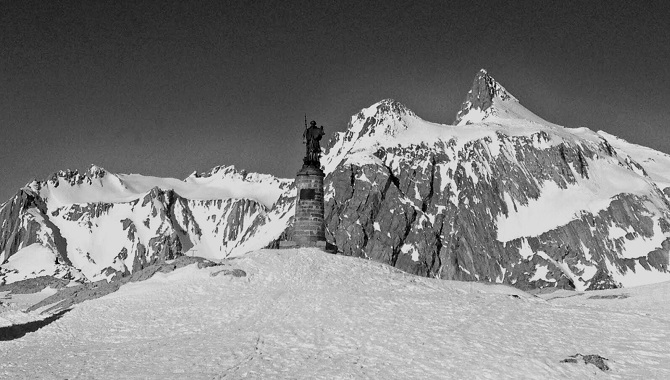 |
 |
The
pass is covered by snow for over seven months a year,
and Bernard identified a need to provide a shelter on
it for pilgrims to escape the ravages of storms and avalanches.
The building was entrusted to Augustinian friars, whose
remit was to pray for, rescue, accompany and welcome the
travellers. These aims are still held to this day, and
it won't escape anyones notice that the door to the monastery
under the passarelle, is never locked shut, whatever the
weather. Bernard also founded a second hospice, on the
pass between Savoy and Val d'Aosta, which has since become
known as the Little Saint Bernard pass.

Bernard died in 1081, then he was cannonised in 1123,
and his saints day is 15th June. In 1923 Pope Pius XI
proclaimed Saint Bernard the patron of those who lived
in the Alps, and of mountain climbers. The photo above
is a statue of Bernard on the pass, with a devil shackled
with a heavy chain at his feet, which symbolises the mastered
perils of the mountains. It is perhaps the history of
Bernard that attracts mountaineers, to make their own
pilgrimage here, to at least give a nod to Bernard in
the hope that he's been keeping a watchful eye over their
antics in the mountains. As both a mountaineer, and mountain
dog owner, the area has always been a magnet for me, and
since my first visit I knew I'd found somewhere special. |
 |
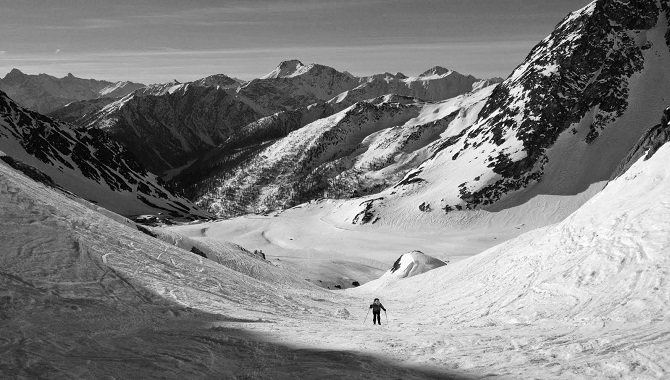 |
 |
More
on the monastery later, but for me the mountains always
draw my eyes upwards, to to them. If you cross the border
from Switzerland into Italy, it's hard to imagine that
there's a small summer road buried metres under the snow.
Mont Fourchon is tucked behind the spectactular shape
of the Pain de Sucre (Sugarloaf) mountain, and the route
turns steeply right up a bowl shaped couloir. Eventually
the gradient slackens off, and you turn west towards the
upper slopes of the mountain. Here Mont Fourchon comes
better into view with every step, and you can marvel at
how well this gem is hidden from view from all those who
don't ascend into the most remote mountains.

As you near the summit, you see many other peaks slipping
below your field of view, and as an extra treat new peaks
reveal themselves over intermediary mountain ridges. None
is finer than the huge bulk of the Grand Combin. At this
higher altitude, the snow transforms and you experience
all consistancies from wind crust to deep fresh powder.
There are a couple of steeper steps on the route, and
the crampon points under the snowshoes are perfect for
providing enough grip for each step. When you've got enough
breath, enjoy the view, as it now extends for hundreds
of kilometers in every direction. Far behind and below
you, is the monastery, and from up here it looks so small
as if its a childs toy, not the large solid building we
left behind in the early morning. |
 |
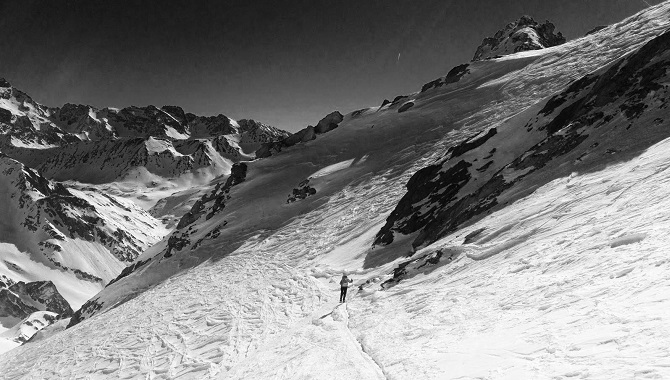 |
 |
The
summit of the mountain is triangular in shape, and sometimes
in soft snow conditions you can reach the very top, whilst
on other occasions it is best to stop just a few metres
below the top, and to savour the views from there. Mont
Fourchon stands at 2902m high, and is only possible in
the winter months on snowshoe or on skis. That is unless
you are a mountain dog, as my Bernese called Maximus has
too reached the summit with no more than his huge paws
for flotation, and strong claws for traction. After taking
the summit photos, the way down the mountain is a dream,
running through soft snow with powder flying up around
you.

It's normal to follow a similar way down the mountain,
as was used for the ascent, but even in the few hours
that the ascent has taken, you'll notice that the snow
has changed. With the avalanche risk normally increasing
throughout the day, as the temperature gradient rises,
it is important to keep going until you reach the small
hut near the buried road, and turn uphill for the short
ascent to the pass. As you come around the corner, it's
the statue of Saint Bernard that is towering above you,
with the monastery framed in the pass behind, on the far
side of the snow covered frozen lake. It can't harm to
say thank you to Bernard as you pass, for watching over
you during your ascent of Mont Fourchon. By this stage
it's usually a happy but weary snowshoer, who walks around
the lake, to push open the welcoming doors of the monastery. |
 |
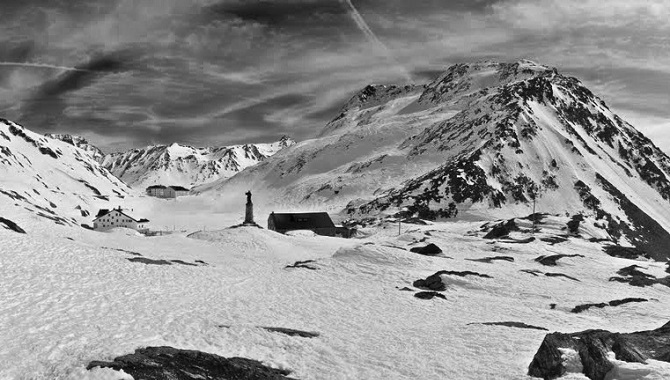 |
 |
The
previous day you'll have ascended to the monastery from
the Super Saint Bernard ski station car park at the entrance
to the tunnel which runs under the mountain. The ascent
to the Grand Saint Bernard generally only takes a few
hours, though this can be longer if there's a lot of fresh
snow. The route follows the valley of the Dranse stream,
on it's right bank, and on the way you'll see a couple
of small shelters that are equiped with stoves, and emergency
phones. These were built for travellers stuck in storms
to seek shelter if they couldn't reach the monastery,
and they have saved lives on many occasions.

In the upper section of the route, before the monastery
is visible, you ascend into the ominous sounding Combe
des Morts (Valley of the Dead). It's a steeper sided valley,
which is more prone to avalanche, and it's caught the
unwary on several times over the years. Don't worry if
you are being guided, as they ware there to assess the
risks, and to manage the risks for you. Just remember
that people have reached the pass for nearly 2000 years
before you, and lived to tell the tale! Julius Caesar
sent his general Servius Galba (later emperor) to secure
the pass after the Battle of Octodurus against the Gallic
army, in what is now called Martigny, to open the route
over the Alps. That was back in the winter of 57-56 BC,
which puts your snowshoeing efforts into perspective somewhat. |
 |
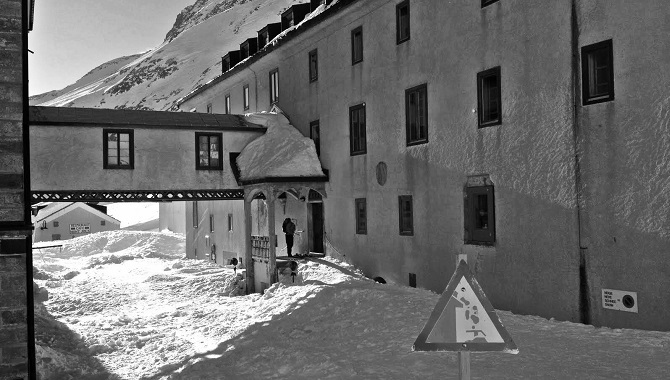 |
 |
The
monastery founded by Bernard gained further notariety
with Napoleon leading the Reserve Army across the pass
in 1800 to break the seige of Genoa by the Austrian forces
using the element of surprise. The battles of Montebello
and Marengo secured the victory for Napoleon, but his
crossing of the pass didn't go unmarked in the monastery.
In the hallway is a huge marble carving dedicated to General
Desaix, who was killed in the battle of 1800, which was
manufactured in Paris and transported by eight hundred
workers up the steep pass in the summer of 1806, on carts
hauled by 30 mules apiece. As well as Napoleonic posturing,
it didn't go unnoticed by the monks that his troops drank
over 22,000 bottles of wine that were in the monastery
wine cellars. Napoleon wasn't famed for paying his bar
bill, and this enormous tab wasn't paid off until 1984,
when French President Francois Mitterand settled the bill
that with inflation had risen to over forty thousand Swiss
francs.

Whilst Napoleon may have stolen wine from the monastery,
he is said to have been the last person to descend into
Italy after every one of his troops has passed before
him, so he did have some standards, just not financial
ones. The monastery hasn't changed much since Napoleonic
times, and the echoing corridors and worn stone steps
bear testament to the thousands of feet that have trodden
here before you. Despite the history of passing armies,
and pilgrims sheltering from violent storms, there is
an unimaginable sense of calm when you enter the building.
You are entering a ship that has weathered thousands of
storms, and in which even if it's the first time you visit,
inexplicably you feel at home and as if somehow you have
been there before. |
 |
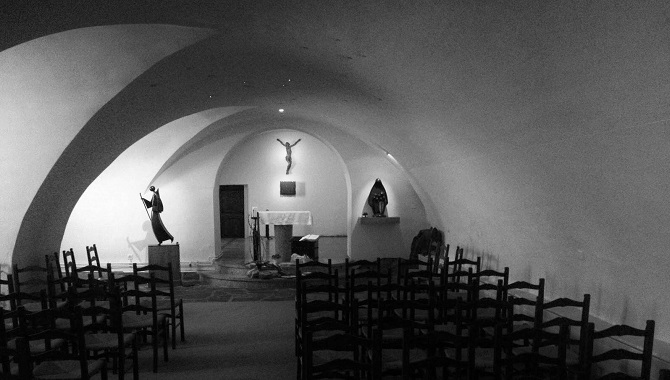 |
 |
I'm
not religious in the slightest, and the main chapel in
the monastery is huge and lavish, and reminds me why I
am so cynical of the spending of the Catholic church.
Underground is the crypt, and each day the monks invite
all the visitors to a simple service, whatever your beliefs
or religion (or lack thereof). The crypt is a very simple
room with a curved ceiling and a very little natural light
filtering in through small stained glass windows that
are buried under the snow. The service is an hour long
and very simple, and the acoustics of the monks melodic
singing is perfect. The sound rises and falls, with every
intonation crystal clear. A sermon in given in French,
with the head monk explaining the focus of the hospice,
and how its goal is to provide solice and calm from the
rigours of the mountain.

There's nothing in the sermon that strikes me as slightly
religious, and generally it's on the same theme about
the role of the hospice and those who work there. The
goals of the monastery have remained unchanged since the
time of Bernard himself, and whilst the modern world has
evolved, little is different in the hospice or in the
mountains in the thousand year history. It's this single
fact that was my epiphany the first time I visited the
place; that thousands had visited before, and thousands
would after me, but that despite being as non-unique as
a grain of sand on a beach, I was welcomed here in this
special place as a valued individual. I may well have
been forgotten the next day, but that didn't matter, as
the good I'd gained from that experience will stay with
me for a long time. This is why I want to share my experiences
of this place with people, so they can see for themselves. |
 |
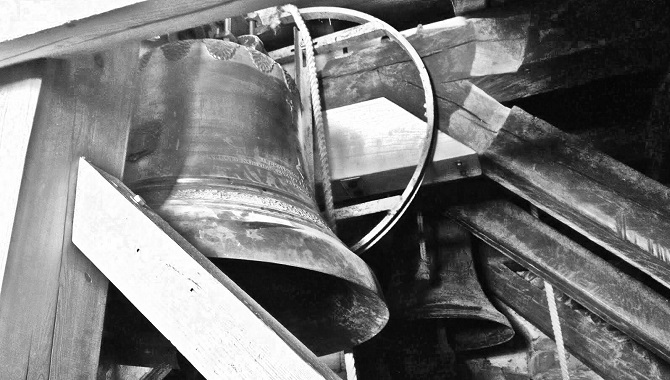 |
 |
Every
time I have visited the monastery, I've discovered some
new hidden aspect, be it the museum in the attic, or the
belfry with its dust covered bells. Did Napoleon hear
those same bells ring out as he finished the 20,000th
bottle of wine, before glissading down the mountain slopes
into Italy? I'll never know, and that's what makes this
place so special. It was my love of the mountains that
attracted me to Mont Fourchon, allied with my interest
in mountain dogs. In doing so, I discovered an amazing
mountain summit, and a fascinating haven to stay in. Many
people write about their experiences and complain about
the length of the beds, or the simplicity of the food,
but I urge you to transcend all that and immerse yourself
in the rich peace of the place, and it cannot fail to
move you.

It was intentional that I put all the photos in this article
in black and white, as it summarises the experience of
snowshoeing to Mont Fourchon and the Grand Saint Bernard
monastery perfectly. I wanted the images to be simple
to mirror the tranquility and peace of the monastery,
but if I've managed to explain myself well, you won't
have noticed they were monochrome, until now. To visit
here teaches you to put yourself into perspective, and
to appreciate the richness of the colours of the surroundings.
What greater riches could anyone want? |
 |
 |
 |
I
hope that this blog article has awakened you to
this amazing region, and that you can dream of joining
me one day to show it to you. If you would like
me to guide you, then please contact me through
Icicle, or direct on Twitter @KingsleyJones |
 |
 |
|
|
 |
|
